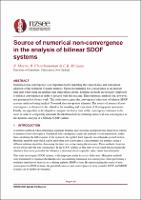| dc.contributor.author | Morris, Nicholas | |
| dc.contributor.author | Chandramohan, Reagan | |
| dc.contributor.author | McGann, Christopher R | |
| dc.date.accessioned | 2023-08-28T04:23:24Z | |
| dc.date.available | 2023-08-28T04:23:24Z | |
| dc.date.issued | 2023-04-19 | |
| dc.identifier.uri | https://repo.nzsee.org.nz/xmlui/handle/nzsee/2568 | |
| dc.description.abstract | Numerical non-convergence is an important factor impeding the research into and widespread adoption of the nonlinear dynamic analysis. Upon encountering non-convergence at an analysis time step when using an implicit time integration scheme, heuristic methods are typically employed to enforce convergence in order to proceed with the analysis. These heuristic methods are, however, not guaranteed to always work. This study investigates the convergence behaviour of bilinear SDOF systems analysed using implicit Newmark time integration schemes. The source of numerical non-convergence is observed to be related to the rounding and truncation of floating-point operations. Finally, an algorithm is developed to compute the lower limit of the convergence tolerance to be used, in order to completely eliminate the likelihood of encountering numerical non-convergence in the dynamic analysis of a bilinear SDOF system. | |
| dc.language.iso | en | |
| dc.publisher | New Zealand Society for Earthquake Engineering | |
| dc.relation.ispartofseries | 2023;30 | |
| dc.subject | Digital and emerging technologies | |
| dc.title | Source of numerical non-convergence in the analysis of bilinear SDOF systems | |
| dc.type | Article | |

